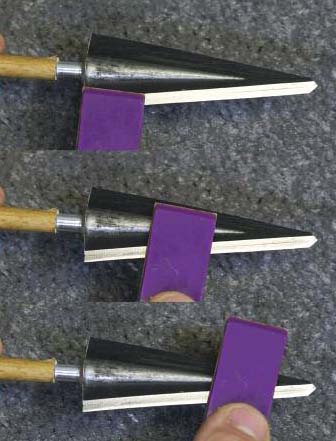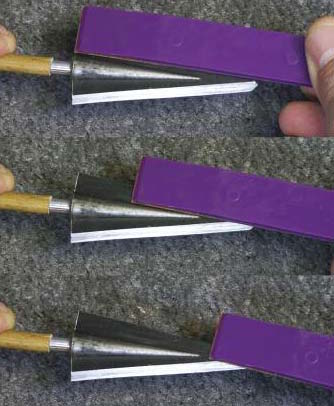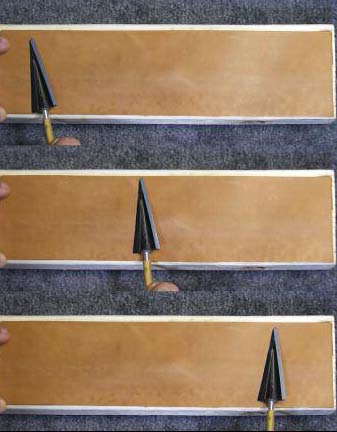Every bowhunter needs a sharp broadhead at the business end of the arrow. Most of us hone our broadheads ourselves, but a truly sharp edge can be elusive for many of us, sometimes seeming like black magic. This tutorial will get you started with a simple method and a pocket kit for honing your broadheads.
There are seemingly endless varieties of broadheads available to the bowhunter, most with either a double bevel or single bevel blade. The first is beveled on both sides of the blade, while a single bevel head has only one side of the blade beveled. Whether double or single bevel, the angle of the beveled edge on the broadhead is important, and most come from the factory with an angle of 25 degrees or less. It doesn’t have to be sharp—that’s your job now. After practicing this method, you will be ready to get it sharp and keep it sharp in the field with a kit that you can take with you anywhere.
One particular scene during an episode of the television series Game of Thrones got my attention when the character John Snow was sharpening his sword using a small hand-held stone. Apparently, this scene caused controversy over why Valerian steel required sharpening. Nonetheless, it provides an example of a sharpening technique that involves moving a small stone over a stationary blade instead of the typical method of moving a blade over a large, stationary stone.

Sharpening the left bevel of a single bevel broadhead with the Buck pen sharpener.
After experimenting with a plethora of techniques, stones, and jigs, I decided to step back and try something a little different. I began with a homemade diamond hone, which I fabricated using a 1” x 3” diamond stone and a wooden paint stirrer for a handle. Small hand-held diamond hones are available commercially and allow for a smaller, more compact sharpening kit. This discovery occurred fortuitously when my brother-in-law harvested a small diamond hone from a beach along Admiralty Inlet, Washington during a family vacation. It had probably been dropped by a salmon fisherman who used it to sharpen hooks. An EZE-Lap diamond hone and stone medium grit that cost less than $10 new, it turned out to be a very nice size and weight for my purposes.

Sharpening the right bevel of a single bevel broadhead. All these procedures are the same for double bevel broadheads.
The general technique involves holding the broadhead stationary while honing it with a small hand-held diamond stone and then stropping to remove what is left of the burr and polish the steel. If you are not familiar with how a burr is formed and removed during the sharpening process, it is worth an Internet search. A thick piece of leather will work nicely for stropping, but you can use cardboard or any number of different materials.
First you will need a hand-held diamond hone like the EZE-Lap. There are several to choose from, including the DMT Dia-Sharp Diamond Mini-Hone Kit and the Lansky Double-Sided Diamond Sharpening Paddle (Lansky #: FP-2860), which has fine and medium grit sides and folds up nicely. Buck makes a compact pen-size sharpener with a retractable diamond hone that is compact and very versatile. It has a flat and round hone on one end and a cone shaped hone on the other end as well as a groove for sharpening hooks, all in medium grit. This single tool will sharpen straight edge broadheads using the flat hone; curved (concave) blade broadheads using the round hone; and you can keep the serrations on your hunting knife sharp using the cone shaped hone! Most of the diamond hones pictured are designed for sharpening in tight places so the gardener in your house will always have sharp pruning sheers. The average cost is between $10 and $30—a small investment compared to most sharpening kits, which can be as complicated as they are costly.
As with learning any new technique, don’t expect perfect results right away and remind yourself frequently to take it slow. Maintaining a consistent angle during any sharpening process is key, so don’t think about removing metal in a hurry. The diamonds will do their job, and yours will be to concentrate on the angle.

Sharpening the flat side of a single bevel broadhead.
To hold the broadhead safely and steadily during the sharpening process, it is advisable to mount it on a cut off arrow to use as a handle. Start off by positioning the edge you are sharpening toward you. Then place the top portion of the diamond hone on the heel of the blade. Make sure it is flat against the bevel angle and use very light pressure on it as you draw it across the bevel. It also helps to have a tight grip on the broadhead so it is stable and a relaxed grip on the diamond hone to feel the angle of the bevel. Keep it slow and steady—at least a one-Mississippi count to move from the heel to the tip. Starting at the bevel just in front of the diamond hone will help keep the same angle over the length of the blade. As you draw the hone across the bevel, move it toward the spine of the blade, alternating sides with five to ten slow strokes until the blade has a sharp edge. If it is double beveled, you will be pulling toward you into the spine once you flip over the broadhead. A single bevel will be flat on the other side, so you need to hold the diamond stone flat against the metal as you hone.
A helpful trick is to use a Sharpie to color the beveled edge so you can see, as you remove metal, whether your angle matches the bevel. You can start with a medium grit hone and then progress to fine grit, if you have both. If you only have a medium grit stone, you can ease up on the already light pressure as you progress.
Once you feel that the blade is getting sharp, it is time for stropping. Use a thick piece of leather approximately 9 inches long by 3-inches wide, with at least a ¼” thickness to give it some stiffness. The purpose of this step is to remove any remaining burr and to polish the edge. Stropping is best known as a means of keeping straight razors sharp in barbershops back in the day, and does not seem to be used much today. However, you may find that stropping will get your blade sharper than you might have thought possible.

Stropping a broadhead with a 9”x3” piece of horse leather.
Strops can be mounted on a piece of wood, while others can be used like a barber’s strop. For this tutorial, the strip of leather is placed on the edge of a table. Start by having the bevel flat against the leather with the edge orientated away from the direction you are moving the broadhead. This will keep the edge from cutting into the leather. Maintaining the correct angle and not pressing the broadhead onto the leather with too much force will result in effective stopping. (If it is a single bevel broadhead, the non-beveled edge should be flat against the leather during stropping.) Stropping five to ten times on each side of the blade before switching to the other side is effective for maintaining the correct angle. The strop should remove what is left of the burr and polish the edge. Once you gain experience with a strop, you might feel some scraping across the leather. This is most noticeable when very light pressure is used during stropping. If the scraping continues, you may need to do a few more light strokes with a fine diamond hone on each side and then continue to strop.
With some practice and development of muscle memory, you will be able to keep your broadheads sharp and have your sharpening kit with you anywhere you go.
Editors’ note: For safety reasons, we recommend wearing light leather gloves while sharpening broadheads, to reduce the chance of accidental cuts and hand injuries.
Cover Image: Examples of various diamond hones that will fit in your pocket. Top to bottom: EZE-Lap diamond hone and stone, Model L; Lansky #FP-2860Diamond Paddle; Lansky Double Side Folding Diamond Paddle Model #LDFPMF; Buck diamond pocket sharpener.







All well & good until one has to deal with something like a four blade Zwickey or the concave edges of a Howard Hill broadhead.
FWIW; Long ago, Dick Garver Sr. taught me the Hill method of sharpening broadheads. It involved sharpening with a file and then raking the edge of the file along the edge of the broadhead, raising a wicked saw-tooth burr. YMMV but I’ve had good luck doing it that way.